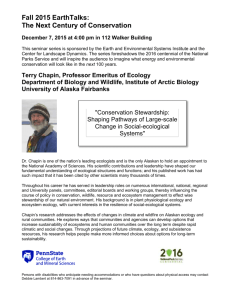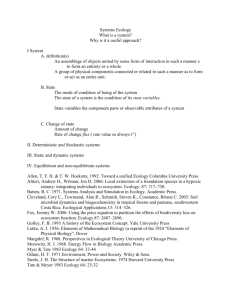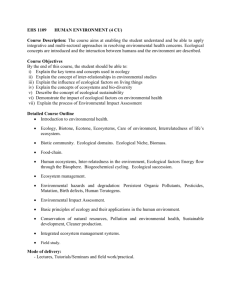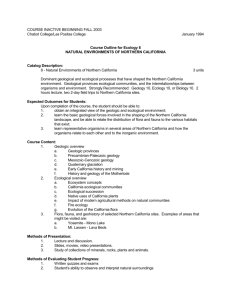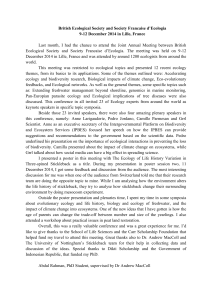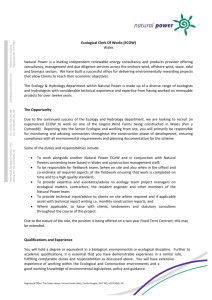Davies_etal_JAE_ms_submitted
advertisement
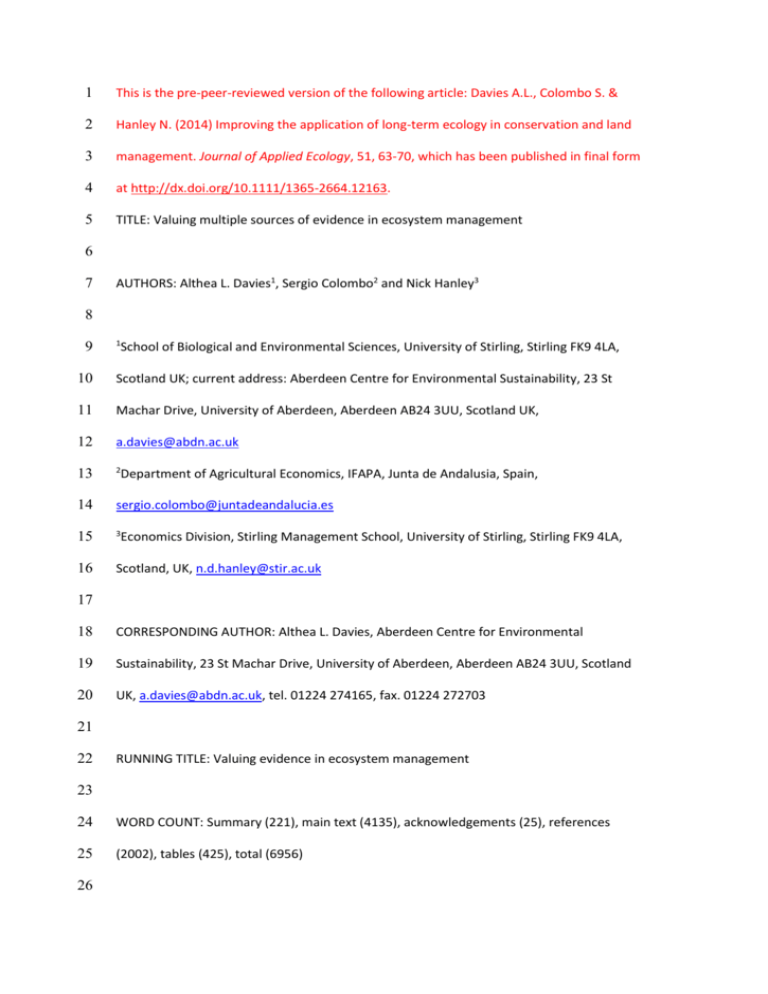
1 This is the pre-peer-reviewed version of the following article: Davies A.L., Colombo S. & 2 Hanley N. (2014) Improving the application of long-term ecology in conservation and land 3 management. Journal of Applied Ecology, 51, 63-70, which has been published in final form 4 at http://dx.doi.org/10.1111/1365-2664.12163. 5 TITLE: Valuing multiple sources of evidence in ecosystem management 6 7 AUTHORS: Althea L. Davies1, Sergio Colombo2 and Nick Hanley3 8 9 1 School of Biological and Environmental Sciences, University of Stirling, Stirling FK9 4LA, 10 Scotland UK; current address: Aberdeen Centre for Environmental Sustainability, 23 St 11 Machar Drive, University of Aberdeen, Aberdeen AB24 3UU, Scotland UK, 12 a.davies@abdn.ac.uk 13 2 14 sergio.colombo@juntadeandalucia.es 15 3 16 Scotland, UK, n.d.hanley@stir.ac.uk Department of Agricultural Economics, IFAPA, Junta de Andalusia, Spain, Economics Division, Stirling Management School, University of Stirling, Stirling FK9 4LA, 17 18 CORRESPONDING AUTHOR: Althea L. Davies, Aberdeen Centre for Environmental 19 Sustainability, 23 St Machar Drive, University of Aberdeen, Aberdeen AB24 3UU, Scotland 20 UK, a.davies@abdn.ac.uk, tel. 01224 274165, fax. 01224 272703 21 22 RUNNING TITLE: Valuing evidence in ecosystem management 23 24 WORD COUNT: Summary (221), main text (4135), acknowledgements (25), references 25 (2002), tables (425), total (6956) 26 27 NUMBER OF TABLES: 3 28 29 30 NUMBER OF REFERENCES: 62 31 Summary 32 1. Significant effort is being made to develop more inclusive and systematic decision- 33 making frameworks in ecology, but these have yet to include palaeoecology which 34 addresses critical questions about long-term ecological processes (data spanning >50 35 years). 36 2. This paper uses a choice experiment format to present long-term data alongside three 37 established sources used in decision-making: ecological monitoring, research and 38 stakeholder participation. This allows researchers, policy-makers and practitioners to 39 consider how evidence outside current frameworks might affect management decisions 40 and outcomes. We use the method to estimate the relative weights that they place on 41 differing types of ecological information, using two UK upland case studies. 42 3. The responses provide the first quantitative indication that ecologists perceive a 43 potential value in longer-term records as an additional source of evidence when making 44 UK upland management decisions. They value both site-specific and broader syntheses 45 of long-term evidence. 46 4. Synthesis and applications: Two opportunities are identified to create more effective, 47 constructive links between ecological, palaeoecological and practitioner interests: (1) 48 participatory approaches currently used to improve the alignment of interests in ecology 49 could be applied to identify common priorities relating to longer-term factors; and (2) 50 the increased availability of databases and interpretative metrics could allow 51 hypothesis-testing and the development of integrative research strategies. These would 52 improve approaches to decision-making by using the full breadth of ecological 53 knowledge. 54 55 Keywords: choice experiment, decision-making framework, evidence-base, integrative 56 ecology, long-term ecology, palaeoecology, stated preference, upland management 57 Introduction 58 The state of the environment and effectiveness of management depend not just on the 59 quality of the evidence, but also on choices in the decision-making process (Sutherland et al. 60 2004; Mathevet & Mauchamp 2005; Kass et al. 2011). Many conservation ecologists 61 recognise the need for decision-making frameworks that accommodate new perspectives 62 and multiple sources of evidence to manage ecosystems for multiple benefits while adapting 63 to uncertainties that lie outside recent experience (Pullin et al. 2004; Heller & Zavaleta 2009; 64 Peters 2010; Polasky et al. 2011). While progress is being made towards more integrative, 65 multi-disciplinary decision-making in some areas (Sutherland et al. 2011), this is not the case 66 for all disciplines relevant to conservation management. 67 68 Long-term ecology (spanning >50 years) has the potential to make significant contributions 69 to these frameworks, but has yet to be routinely recognised in ecological research, policy or 70 practice (Willis & Bhagwat 2010; Rull & Vegas-Vilarrúbia 2011). Davies and Bunting (2010) 71 suggest that answering 54 of the 100 questions of UK conservation importance (Sutherland 72 et al. 2006) requires consideration of processes acting over multiple years or of conditions in 73 the past and present. Many palaeoecological papers address themes raised by these 100 74 questions (e.g. Willis et al. 2007; Vegas-Vilarrúbia et al. 2011), indicating the relevance of 75 long-term data to conservation priorities on an international level. However, only 16% of 76 studies published in the Journal of Applied Ecology in 1999 addressed timescales greater 77 than a decade (Ormerod, Pienkowski & Watkinson 1999), and no key biodiversity 78 assessments published between 1998 and 2005 used records longer than 50 years (Willis et 79 al. 2005). The lack of long-term perspectives in ecological policy and research is more than 80 an issue of academic recognition: it has implications for the effectiveness of management 81 interventions and investment. For example, in marine ecosystems, omission of historical 82 data results in overly optimistic assessments of conservation status, lower recovery targets 83 and higher fisheries quotas (McClenachan, Ferretti & Baum 2012). 84 85 In addition to numerous barriers to the uptake of unfamiliar methods (see Context), there is 86 a lack of basic empirical evidence on the attitudes of those involved in conservation 87 management towards multiple sources of evidence, including long-term ecology (LTE). To 88 establish the willingness of researchers, policy-makers and practitioners to incorporate less 89 familiar forms of evidence into decision-making, this paper uses a choice experiment 90 (Hensher, Rose & Greene 2005) to assess the relative merits of four sources of information 91 on ecosystem functioning: ecological monitoring, ecological research, LTE and stakeholder 92 participation. This allows the relative value of each source to be assessed and quantified, as 93 perceived by conservation managers and scientists. We apply this method to a case study on 94 UK upland conservation issues. The two ecosystems used as the context for this study are 95 sensitive to climatic and management change, and provide many ecosystem services, with 96 beneficiaries well beyond the geographical limits of the uplands (Holden et al. 2007, Reed et 97 al. 2009). Reliance on partial information has potentially significant and widespread 98 implications for the long-term supply of these ecosystem services. 99 100 The results provide a first quantitative assessment of how LTE is regarded by ecologists who 101 contribute to the evidence-base, implement conservation management and inform policy- 102 makers, relative to more familiar sources of evidence. We use the responses to suggest ways 103 of developing a more inclusive framework of shared priorities and integrative research 104 strategy, drawing on measures being used to improve the alignment of interests across 105 conservation research, policy and practice (Sutherland et al. 2011). 106 107 108 Context: challenges and limitations in valuing diverse knowledge 109 The main barriers to knowledge exchange relevant to LTE are outlined before describing the 110 value of choice experiments for understanding attitudes towards unfamiliar sources of 111 evidence. 112 113 Three interrelated sets of issues limit knowledge exchange between researchers, 114 practitioners and policy-makers within and between ecology and palaeoecology. First, a lack 115 of availability or awareness of relevant long-term and neo-ecological information 116 contributes to differing priorities and a misalignment of interests (Sutherland et al. 2009). 117 This is due to insufficient evidence, a shortage of accessible or coordinated data, and 118 insufficient communication or evaluation of the effectiveness of existing information (Pullin 119 et al. 2004; Willis et al. 2007; Newton et al. 2009; Davies & Bunting 2010). Second, 120 infrastructural and technical obstacles reduce opportunities for exchange and learning. 121 These include the lack of a support framework and accessible measures for exchange, 122 collation and evaluation of knowledge (Sutherland et al. 2004; Newton et al. 2009). A lack of 123 time, education and training to provide exposure to relevant ideas from other fields, and 124 differences in the ways that various methods record information can further restrict data 125 comparability (Davies & Bunting 2010). This includes the challenge of translating data into 126 understandable, meaningful formats for other audiences without compromising levels of 127 detail or uncertainty. Finally, attitudes and preconceptions influence the reception of 128 unfamiliar evidence. This includes the perception that longer records are time-bound, purely 129 descriptive and of little use in conservation practice (Willis et al. 2007), or failure amongst 130 some palaeoecologists to consider conservation ecology as a relevant audience and frame 131 their data accordingly (Birks 2012). It can include uncertainty over data precision or 132 accuracy, and reluctance to use data that do not arise from well-controlled experiments 133 (Dietl & Flessa 2011). There may also be cultural resistance to changing established thinking 134 and a tendency to defend established approaches (e.g. Carrion & Fernandez 2009, and 135 responses thereto), or to focus on the shortcomings of differing sources rather than 136 developing strategies to overcome them (Froyd & Willis 2008). 137 138 There are few opportunities for researchers, policy-makers and practitioners to 139 simultaneously consider how information from different sources might affect management 140 decisions and their environmental outcomes. Unless the actual and perceived relevance of 141 other sources is assessed, there is a risk that knowledge exchange networks will remain 142 biased towards a subset of established views, rather than accommodating multiple insights 143 (Sutherland et al. 2004). This paper uses a choice experiment (CE) as a structured format for 144 deriving participant preferences towards different sources of knowledge. CEs have several 145 strengths relevant for assessing the relative weight that researchers, policy-makers and 146 practitioners place on LTE in decision-making. First, CEs have been widely used to value 147 ecosystem attributes that are unfamiliar to many stakeholders and lack easily defined 148 market values. This includes being used to assess how complex concepts like biodiversity are 149 understood and valued by the general public (Christie et al. 2006). A variant of the method 150 has also been used to assess how unfamiliar evidence, like the extent of historical woodland 151 change, affects preferences for future changes in tree cover (Hanley et al. 2009). Second, 152 CEs take into account the fact that complex decisions are based on multiple decision- 153 relevant criteria by facilitating simultaneous consideration of multiple dimensions of 154 conservation problems, such as changes in raptor populations and local employment under 155 alternative management regimes on sporting estates (N. Hanley, unpublished data). Third, 156 the method enables researchers to estimate the relative values of multiple attributes of 157 ecological change in a manner consistent with well-established principles in decision science 158 (Louviere, Hensher & Swait 2000). Finally, CEs can be used to assess how individuals make 159 trade-offs when multiple, competing benefits and values are involved, as for example in 160 managing ecosystem services (Birol et al. 2009). 161 162 Most CEs have been carried out with members of the public in order to inform policy-makers 163 about preferences held by tax-payers, rather than with ‘professional’ participants like 164 ecologists (Burgess, Clark & Harrison 2000) or policy makers (Carlsson, Kataria & Lampi 165 2011). In contrast, recent efforts to improve policy-making relating to conservation and 166 ecology have involved researchers, practitioners and policy-makers to identify common 167 priorities and emerging issues (Sutherland et al. 2011). By involving ecological researchers 168 and practitioners, this paper bridges a gap in CE applications and extends the conservation 169 decision-making literature by considering the relative merits of longer-term perspectives 170 alongside established sources of evidence. 171 172 173 Materials and methods 174 Construction of a comparative evidence-base 175 CEs are a stated preference technique developed in market research, but now used in a 176 range of applications (Bateman et al. 2002). Respondents are required to make a series of 177 choices between alternative scenarios to identify their preferences and the trade-offs that 178 they are willing to make between different “attributes” of a policy option or consumer good. 179 Choices are specified in terms of a number of attributes, each of which is available at 180 different levels. Experimental design consists of selecting attributes and levels, and 181 combining them into a series of choice tasks which respondents complete. In this case, 182 participants considered four types of evidence within an upland management context (Table 183 1). The following attributes used in the experimental design: 184 1. Ecological monitoring is used to detect trends and evaluate management effectiveness. 185 Monitoring frequency depends on resources and objectives, including species and 186 ecosystem response rates. Three levels were included in the CE: 3 years, 6 years (the 187 approximate interval in site condition monitoring, the standard approach for monitoring 188 designated sites) and 12 years. 189 2. Ecological research provides the basis for understanding ecosystem behaviour and the 190 underpinning mechanisms, from genome to biosphere scales. Two attribute levels were 191 included in the CE: none (monitoring evidence is sufficient), and diverse (encompassing a 192 broad range of ecological insights, including climate modelling, genetics or carbon 193 chemistry, for example). 194 3. Long-term ecological data: Since many ecosystem processes operate over long periods, 195 baselines may shift between each generation of policy-makers, researchers and 196 managers who see only part of the process. This has direct consequences for species and 197 ecosystem management (McClenachan, Ferretti & Baum 2012). In this context, ‘long- 198 term’ refers to records spanning >50 years. Three attribute levels were included: none, 199 syntheses (broad-scale) and region- or site-specific data (finer spatial scale). 200 4. Stakeholder engagement: Translating evidence into effective policy and practice requires 201 locally adapted planning and implementation (Heller & Zavaleta 2009). Stakeholder 202 participation is increasingly advocated as a means of generating more adaptive and 203 acceptable management decisions (Reed 2008) and can improve synergies between 204 research, policy and practice (Sutherland et al. 2011). Three attribute levels were 205 included to reflect different levels of participation: none, guidance (stakeholder 206 knowledge or preferences used to implement pre-determined research, policy or 207 management strategies), and collaboration (co-generation of research agendas, 208 management or policy approaches). 209 210 CEs usually incorporate a price attribute to assess how much participants are willing to pay 211 to maintain particular landscape characteristics or to support a change in management, for 212 example. Monetary costs are not appropriate for valuing different forms of knowledge 213 directly, but time is included as a fifth attribute to represent the costs associated with 214 changing or broadening the evidence-base used to support management decisions. These 215 costs are prospectively incurred by in acquiring new information, through the time taken to 216 gain a basic understanding of additional sources, keep abreast of developments in a wider 217 range of fields, or take part in meetings or projects in order to obtain additional types of 218 evidence. Three time costs are included in the CE: one day/quarter, one day/month and one 219 day/week. This cost relates to how much working time would be allocated within a 220 participant’s organisation, rather than the level of the individual involved in the CE. 221 222 To provide a real-world context, information on each attribute was presented to participants 223 before the choice cards relating to two practical UK conservation issues: the management of 224 peatlands and the management of upland woodlands, in each case with the aim of 225 maintaining ecosystem viability. These contexts were selected because their management 226 incorporates a range of biotic and abiotic interactions, with scope for broad disciplinary and 227 knowledge input. They also provide a wide range of ecosystem services (Bonn, Allott & 228 Hubacek 2008) and include values arising from a complex palimpsest of cultural activities 229 and environmental changes on recent to millennial timescales (Tallis 1998). 230 231 In applying a CE to evaluate how information provision influences participant preferences, 232 the clarity, relevance and acceptability of that evidence is paramount. Therefore information 233 on each attribute was drawn from peer-reviewed literature and best practice guidance 234 (Appendices S1-S3 in Supporting Information). Feedback was obtained from two upland 235 ecologists on a draft version and via a pilot CE. The information aimed to summarise the 236 current state of knowledge with a focus on ecosystem process and function, in the context 237 of key management issues (e.g. Holden et al. 2007; Hopkins & Kirby 2007; Sutherland et al. 238 2006, 2010). 239 240 Experimental design and implementation 241 The CE was designed and implemented in two stages. A pilot was conducted with a small 242 number of participants to improve the statistical efficiency and ease of use of the final 243 design. The pilot set of 18 choice cards, which presented different combinations of the 244 attributes and levels described above, was designed using online software, based on the 245 method of Street and Burgess (2007). Attribute levels were combined orthogonally to allow 246 an estimate of the relative value of each attribute to the overall preferences of respondents. 247 Respondents were asked to respond to both case studies (peatland and woodland). The pilot 248 included post-CE questions on the amount, relevance and clarity of information presented. 249 250 The full survey was developed using a mixed design, combining multi-nomial logit and mixed 251 multi-nomial logit panel designs. A D-optimal design (Rose & Bliemer 2009) was used to 252 combine the attributes offered to respondents. Such design requires explicit incorporation 253 of prior information about respondents’ preferences. This was obtained from the mean and 254 standard deviations of the estimated attribute coefficients from the pilot survey, on the 255 assumption that respondent preferences for the full survey sample will lie within this range. 256 Coefficients which were not significant in the pilot were assigned a fixed zero value. 257 Participants were asked to select the context (woodland or peatland) with which they were 258 most familiar before completing the full CE. Each participant completed 18 choice cards. 259 260 The survey was completed by professionals with experience of the habitats and issues 261 described. Participants were recruited via personal contacts, email invitations to members of 262 UK upland policy and research networks, and additional participants suggested by these 263 respondents, incorporating a range of government agencies and non-governmental 264 organisations, and UK researchers and practitioners. The main survey was conducted via an 265 online format, with the option for email responses. All responses were treated 266 anonymously. 267 268 269 Results 270 Sixteen completed responses were received for the main survey, including one NGO 271 ecologist, one policy-maker, three practitioners, five researchers (including one long-term 272 researcher) and six agency ecologists, drawn from England, Wales, Scotland and the Irish 273 Republic. 274 275 A random parameter logit model using normally distributed preferences provided the best 276 fit for both CEs. In the peatland CE (Table 2), for the non-random parameters in each 277 respondents’ preference, ecological research is significantly valued relative to no such 278 research input to decision-making, as is LTE at both “synthesis” and “specific“ levels, with a 279 slight preference for the former. Time commitments to information processing are not 280 significant determinants of choice. Preferences vary significantly across respondents for 281 ecological monitoring and stakeholder inputs. Preferences for ecological monitoring at 3 282 year intervals do not differ from those at 6 year intervals, but respondents respond 283 negatively to a change to monitoring at 12 year intervals. Both stakeholder guidance and 284 collaboration were valued relative to no such involvement, with a higher value placed on 285 collaboration than guidance. Preferences for all four information attributes display 286 significant heterogeneity, as standard deviation estimates are strongly significant. 287 288 In the woodland case study (Table 3), the model fit is not as strong as for the peatland CE 289 (pseudo R2 of 0.38 relative to 0.52: values of 0.2-0.4 are equivalent to R2 of 0.7-0.9 in 290 standard linear models). In contrast with the peatland CE, there is no significant preference 291 for ecological monitoring intervals differing from a 6 year frequency, since parameter 292 estimates for 3-year and 12-year intervals are insignificant. All respondents consider 293 ecological research to be valuable. Both synthesis-level and more specific LTE data are 294 preferred to none. The larger coefficient for site-specific (1.59) over synthesis LTE data (1.36) 295 reveals that the former is slightly preferred. Stakeholder involvement is preferred relative to 296 none, with collaboration preferred (0.86) over guidance (0.69). The lowest time demand 297 (once/4 months) is preferred over monthly or weekly time inputs, and in contrast to the 298 peatland CE, both these measures of time demand are of significance to respondents, as 299 shown by statistically significant negative parameter estimates for both the 1 day/month 300 and the 1 day/week attribute levels. There is statistically significant heterogeneity in values 301 attached to the frequency of ecological monitoring and to ecological research as inputs to 302 management decision-making. 303 304 305 Discussion 306 The CE results and their potential wider applicability are discussed before considering 307 opportunities and methods of creating more integrative ecological decision-making 308 frameworks. 309 310 Preferences towards long-term ecology in the upland evidence-base 311 Unsurprisingly, participants place a statistically significant value on ecological research, but 312 the CE results provide the first quantitative indication that ecologists perceive a potential 313 value in longer-term records as an additional source of evidence when making management 314 decisions. This can be seen from the positive and significant parameter estimates for the LTE 315 attribute, relative to none being provided. Variations in the value placed on synthesis-level 316 compared to region- or site-specific LTE may reflect the supporting information presented to 317 participants, which summarised the current state of knowledge: regional variations in the 318 timing and extent of range shifts are more pronounced for UK woodlands (Appendix S2) than 319 peatlands (Appendix S1), albeit with significant dynamism in both habitats. A preference for 320 site-specific and broad-scale woodland data may reflect current management concerns, like 321 the continuing contraction of old-growth woodland (Hopkins & Kirby 2007) compared with 322 the relative stability of moorland extent since the 1990s (Countryside Survey 2007). 323 Concerns nevertheless persist over the condition of both ecosystems and their ability to 324 provide ecosystem services (Quine et al. 2011). Similar factors may explain the preferences 325 towards ecological monitoring, in that participants have no statistically significant 326 preferences for changes from the current c.6 year interval for woodlands, but viewed 12 327 year intervals as less desirable than 3- or 6-year intervals on peatlands. This could reflect 328 more rapid response rates in peatland species (e.g. to restoration and burning 329 management), compared with slower growth rates and generation times for trees. 330 331 Preferences towards stakeholder engagement varied between participants, but some level 332 of involvement was significantly preferred over none. In both case studies, collaboration was 333 preferred to using stakeholder knowledge to help implement pre-determined strategies. 334 Finally, for peatlands, time costs within a participant’s organisation were not viewed as a 335 significant factor. For woodlands, the lowest time demand (one day/quarter) was preferred 336 to higher levels. In the case of peatlands, this suggests that changes are not seen as 337 significantly different from current requirements, or that it is difficult to estimate on an 338 organisational rather than individual level, so that participants chose not to focus on this 339 attribute when making their choices. For woodlands, participants clearly viewed an increase 340 to one day/week for acquiring new information as a significant and undesirable burden. 341 342 While the small sample size and inability of participants to query the dataset or discuss 343 reasons for their choices restrict the wider inferences that can be drawn from the data, the 344 consistency of the results across a range of participant positions (government agency and 345 policy, academics and practitioners) suggests that these preferences could have broader 346 relevance and applicability, at least within UK upland management. 347 348 Building an integrative approach 349 As discussed earlier, three common barriers restrict knowledge exchange and the alignment 350 of interests between palaeoecologists, ecologists, policy-makers and practitioners: a lack of 351 availability and awareness, technical and infrastructural barriers, and attitudes and 352 preconceptions. This CE contributes to the first and last of these by allowing respondents to 353 simultaneously consider evidence from different disciplines, assess their attitudes toward a 354 broader evidence-base, and consider the relative values of different types of information 355 relevant to conservation management. Although the results suggest a willingness to accept 356 LTE alongside ecological research, monitoring and stakeholder inputs, this evidence has yet 357 to be incorporated into the evidence-base or decision-making frameworks, such as recent 358 priority-setting and horizon-scanning activities (Sutherland et al. 2008). More proactive 359 approaches may therefore be needed to shift current conventions (cf. Turnpenny 2012). The 360 remainder of the discussion assesses how the trend towards more systematic and inclusive 361 frameworks in ecology and conservation, methodological developments and ecological 362 comment on long-term trends could be used to bring about closer integration of timeseries 363 datasets. 364 365 The CE format allowed different sources of knowledge to be considered simultaneously, but 366 the online application method did allow discussion or debate. Participatory processes like 367 those used in recent ecological priority-setting and horizon-scanning exercises (Sutherland et 368 al. 2011) can help identify shared priorities and gaps in knowledge or understanding, and 369 frame long-term messages around key ecological and policy questions to increase 370 interdisciplinary relevance and awareness (Davies & Bunting 2010; Dietl & Flessa 2011). 371 Generating open debate over the values and preconceptions that influence decision-making 372 can challenge mutual assumptions, encourage lateral thinking across disciplinary boundaries 373 and so stimulate collaboration and more effective knowledge exchange (Willis et al. 2007; 374 Froyd & Willis 2008; Sutherland et al. 2008, 2011). This approach is currently being 375 developed to establish the most pressing questions in palaeoecology for addressing key 376 ecological issues in the Anthropocene. Based on the CE results, collaborative priorities could 377 incorporate both habitat-specific implications (Chambers, Mauquoy & Todd 1999) and 378 broader, thematic priorities like biodiversity (Willis et al. 2007). At the site level, identifying 379 common interests could stimulate palaeoenvironmental analyses at existing long-term 380 ecological monitoring sites to encourage interdisciplinary hypothesis-testing (Froyd & Willis 381 2008). Site-level interaction between palaeoecologists, managers and practitioners could 382 allow differing perspectives to fulfil complementary roles: LTE, empirical records and 383 ecological modelling inform our understanding of processes and assist in predicting future 384 responses, while experimental data, systematic surveys and experiential knowledge help 385 indicate the management tools needed to achieve desired longer-term outcomes (Davies 386 2011). 387 388 In addition to collaborative priority-setting initiatives, additional recent trends in ecology 389 suggest a window of opportunity for connecting across ecological timescales. These include 390 the increase in ‘revisiting’ studies which assess the extent of change over the course of the 391 20th century (Hopkins & Kirby 2007; Kapfer et al. 2011; Newton et al. 2012), the emergence 392 from established monitoring networks of biophysical trends spanning multiple decades 393 (Monteith & Evans 2005; Morecroft et al. 2009; Youngblood & Palkin 2011) and the growing 394 number of ecological papers stressing the relationship between past management and 395 current conservation status (Gustavsson, Lennartsson & Emanuelsson 2007; Wyatt & Silman 396 2010). 397 398 To help overcome technical barriers, databases for storing and disseminating the growing 399 volume of ecological and palaeoenvironmental data (Dengler et al. 2011, Fyfe et al. 2009) 400 and systematic reviews (Pullin & Stewart 2006) provide accessible, standardised tools for 401 coordinating a more inclusive multi-scale evidence-base (McMahon et al. 2011; Sergeant et 402 al. 2012). For example, systematic, accessible archives combined with statistical tools allow 403 hypothesis-testing across spatial and timescales (McMahon et al. 2011). Many ecological 404 and environmental insights are communicated using indices and models to quantify the 405 extent and rate of environmental change and to represent aspects of ecosystem structure 406 and function (e.g. Gritti et al. 2004; Newton et al. 2012). As methods for representing 407 system complexity, these could help communicate and compare insights from different 408 analytical methods (e.g. Jeffers et al. 2011) and stimulate further development of cross-scale 409 metrics (Polly et al. 2011) to address issues of data accessibility and comparability (Froyd & 410 Willis 2008; Davies & Bunting 2010) which prevent direct comparisons of proxy (palaeo), 411 observational and instrumental records. 412 413 Conclusions 414 Publications discussing the value of long-term ecology (>50 years) for conservation policy 415 and management make a strong case for their inclusion alongside other ecological inputs, 416 but this has yet to become established in practice and it is unclear how these long-term 417 messages are received by an ecological or policy audience. By providing a format in which 418 different knowledge sources could be concurrently assessed, the choice experiment 419 discussed in this paper suggests that participating researchers, practitioners and policy 420 advisors value long-term ecological insights alongside empirical and predictive ecology, 421 ecological monitoring and stakeholder knowledge for UK upland management. This includes 422 site-specific and broader syntheses of long-term evidence. By engaging ‘professional’ 423 respondents with a direct stake and high level of involvement in the production and use of 424 the evidence-base, rather than the general public, this CE addresses aspects of ecosystem 425 complexity and recognises the difficult choices involved in decision-making. To develop this 426 potential, collaborative exercises currently used to identify common priorities in ecology 427 provide the logical next steps for generating dialogue and building more integrative 428 frameworks between these communities. There is also an opportunity for palaeoecologists 429 to build on the multi-decadal trends emerging from established long-term monitoring and 430 survey networks. Incorporating long-term datasets into conservation and management 431 frameworks presents challenges, but continuing to overlook information on longer-term 432 ecosystem function and process represents an even greater risk to the future effectiveness 433 of management decisions. Given the mounting pressures on ecosystems and time delays 434 between information gathering, policy development and implementation, more proactive 435 approaches are needed to apply the full breadth of existing knowledge. 436 437 438 Acknowledgements 439 This research was funded by the Economic and Social Research Council through the Rural 440 Economy and Land-Use Programme (RES-229-27-0003). Thanks to choice experiment 441 participants. 442 443 444 References 445 Bateman, I.J., Carson, R.T., Day, B., Hanemann, M., Hanley, N., Hett, T., Jones-Lee, M., 446 Loomes, G., Mourato, S., Ozdemiroglu, E., Pearce, D., Sugden, R. & Swanson, J. (2002) 447 Economic valuation with stated preference techniques: a manual. Edward Elgar, Cheltenham. 448 Birks, H.J.B. (2012) Ecological palaeoecology and conservation biology: controversies, 449 challenges, and compromises. International Journal of Biodiversity Science, Ecosystem 450 Services and Management, DOI: 10.1080/21513732.2012.701667. 451 Birol, E., Hanley, N., Koundouri, P. & Kountouris, Y. (2009) Optimal management of 452 wetlands: Quantifying trade-offs between flood risks, recreation, and biodiversity 453 conservation. Water Resources Research, 45, W11426, DOI: 10.1029/2008WR006955 454 Bonn, A., Allott, T. & Hubacek, K. (2008) Drivers of environmental change in uplands. 455 Routledge, London. 456 Burgess, J., Clark, J. & Harrison, C.M. (2000) Knowledges in action: an actor network analysis 457 of a wetland agri-environment scheme. Ecological Economics, 35, 119-132. 458 Carlsson F., Kataria, M. & Lampi, E. (2011) Do EPA administrators recommend environmental 459 policies that citizens want? Land Economics, 87, 60-74. 460 Carrion, J.S. & Fernandez, S. (2009) The survival of the 'natural potential vegetation' concept 461 (or the power of tradition). Journal of Biogeography, 36, 2202-2203. 462 Chambers, F.M., Mauquoy, D. & Todd, P.A. (1999) Recent rise to dominance of Molinia 463 caerulea in environmentally sensitive areas: new perspectives from palaeoecological data. 464 Journal of Applied Ecology, 36, 719-733. 465 Christie, M., Hanley, N., Warren, J., Murphy, K., Wright, R., & Hyde, T. (2006) Valuing the 466 diversity of biodiversity. Ecological Economics, 58, 304-317. 467 Countryside Survey (2007) UK results from 2007, chapter 7: Mountain, moor and heath. 468 CEH/NERC, pp. 68-84. 469 Davies, A.L. (2011) Long-term approaches to native woodland restoration: palaeoecological 470 and stakeholder perspectives on Atlantic forests of Northern Europe. Forest Ecology and 471 Management, 261, 751-763. 472 Davies, A.L. & Bunting, M.J. (2010) Applications of palaeoecology in conservation. The Open 473 Ecology Journal, 3, 54-67. 474 Dengler, J., Jansen, F., Glöckler, F., Peet, R.K., De Cáceres, M., Chytrý, M., Ewald, J., Oldeland, 475 J., Lopez-Gonzalez, G., Finckh, M., Mucina, L., Rodwell, J S., Schaminée, J.H.J. & Spencer, N. 476 (2011) The Global Index of Vegetation-Plot Databases (GIVD): a new resource for vegetation 477 science. Journal of Vegetation Science, 22, 582-597. 478 Dietl, G.P. & Flessa, K.W. (2011) Conservation paleobiology: putting the dead to work. Trends 479 in Ecology & Evolution, 26, 30-37. 480 Froyd, C.A. & Willis, K.J. (2008) Emerging issues in biodiversity & conservation management: 481 The need for a palaeoecological perspective. Quaternary Science Reviews, 27, 1723-1732. 482 Fyfe, R., de Beaulieu, J.L., Binney, H., Bradshaw, R., Brewer, S., Le Flao, A., Finsinger, W., 483 Gaillard, M.-J., Giesecke, T., Gil-Romera, G., Grimm, E., Huntley, B., Kunes, P., Kuhl, N., 484 Leydet, M., Lotter, A., Tarasov, P. & Tonkov, S. (2009) The European Pollen Database: past 485 efforts and current activities. Vegetation History and Archaeobotany, 18, 417-424. 486 Gritti, E.S., Gachet, S., Sykes, M.T. & Guiot, J. (2004) An extended probabilistic approach of 487 plant vital attributes: an application to European pollen records at 0 and 6 ka. Global Ecology 488 and Biogeography, 13, 519-533. 489 Gustavsson, E., Lennartsson, T. & Emanuelsson, M. (2007) Land use more than 200 years ago 490 explains current grassland plant diversity in a Swedish agricultural landscape. Biological 491 Conservation, 138, 47-59. 492 Hanley, N., Davies, A., Angelopoulos, K., Hamilton, A., Ross, A., Tinch, D., & Watson, F. (2008) 493 Economic determinants of biodiversity change over a 400 year period in the Scottish 494 uplands, Journal of Applied Ecology, 45, 1557-1565. 495 Hanley, N., Ready, R., Colombo, S., Watson, F., Stewart, M. & Bergmann, E. A. (2009) The 496 impacts of knowledge of the past on preferences for future landscape change. Journal of 497 Environmental Management, 90, 1404-1412. 498 Heller, N.E. & Zavaleta, E.S. (2009) Biodiversity management in the face of climate change: A 499 review of 22 years of recommendations. Biological Conservation, 142, 14-32. 500 Hensher, D.A., Rose, J.M. & Greene, W. H. (2005) Applied choice analysis: a primer. 501 Cambridge University Press, Cambridge. 502 Holden, J., Shotbolt, L., Bonn, A., Burt, T.P., Chapman, P J., Dougill, A.J., Fraser, E.D.G., 503 Hubacek, K., Irvine, B., Kirkby, M.J., Reed, M.S., Prell, C., Stagl, S., Stringer, L.C., Turner, A. & 504 Worrall, F. (2007) Environmental change in moorland landscapes. Earth-Science Reviews, 82, 505 75-100. 506 Hopkins, J.J. & Kirby, K.J. (2007) Ecological change in British broadleaved woodland since 507 1947. Ibis, 149, 29-40. 508 Jeffers, E.S., Bonsall, M.B., Watson, J.E. & Willis, K.J. (2011) Climate change impacts on 509 ecosystem functioning: evidence from an Empetrum heathland. New Phytologist, 193, 150- 510 164. 511 Kapfer, J., Grytnes, J.A., Gunnarsson, U. & Birks, H.J.B. (2011) Fine-scale changes in 512 vegetation composition in a boreal mire over 50 years. Journal of Ecology, 99, 1179–1189. 513 Kass, G.S., Shaw, R.F., Tew, T. & Macdonald, D.W. (2011) Securing the future of the natural 514 environment: using scenarios to anticipate challenges to biodiversity, landscapes and public 515 engagement with nature. Journal of Applied Ecology, 48, 1518-1526. 516 Louviere, J.J., Hensher, D.A. & Swait, J.D. (2000) Stated choice methods: analysis and 517 applications. Cambridge University Press, Cambridge. 518 Mathevet, R. & Mauchamp, A. (2005) Evidence-based conservation: dealing with social 519 issues. Trends in Ecology & Evolution, 20, 422-423. 520 McClenachan, L., Ferretti, F. & Baum, J. K. (2012) From archives to conservation: why 521 historical data are needed to set baselines for marine animals and ecosystems. Conservation 522 Letters, 5, 349–359. 523 McMahon, S.M., Harrison, S.P., Armbruster, W.S., Bartlein, P.J., Beale, C.M., Edwards, M.E., 524 Kattge, J., Midgley, G., Morin, X. & Prentice, I.C. (2011) Improving assessment and modelling 525 of climate change impacts on global terrestrial biodiversity. Trends in Ecology & Evolution, 526 26, 249-259. 527 Monteith, D.T. & Evans, C.D. (2005) The United Kingdom Acid Waters Monitoring Network: a 528 review of the first 15 years and introduction to the special issue. Environmental Pollution, 529 137, 3-13. 530 Morecroft, M.D., Bealey, C.E., Beaumont, D.A., Benham, S., Brooks, D.R., Burt, T.P., Critchley, 531 C.N.R., Dick, J., Littlewood, N.A., Monteith, D.T., Scott, W.A., Smith, R.I., Walmsley, C. & 532 Watson, H. (2009) The UK Environmental Change Network: Emerging trends in the 533 composition of plant and animal communities and the physical environment. Biological 534 Conservation, 142, 2814-2832. 535 Newton, A.C., Stewart, G.B., Myers, G., Diaz, A., Lake, S., Bullock, J.M. & Pullin, A.S. (2009) 536 Impacts of grazing on lowland heathland in north-west Europe. Biological Conservation, 142, 537 935-947. 538 Newton, A.C., Walls, R. M., Golicher, D., Keith, S.A., Diaz, A, & Bullock, J.M. (2012) Structure, 539 composition and dynamics of a calcareous grassland metacommunity over a 70-year 540 interval. Journal of Ecology, 100, 196-209. 541 Ormerod, S.J., Pienkowski, M.W. & Watkinson, A.R. (1999) Communicating the value of 542 ecology. Journal of Applied Ecology, 36, 847–855. 543 Peters, D.P.C. (2010) Accessible ecology: synthesis of the long, deep, and broad. Trends in 544 Ecology & Evolution, 25, 592-601. 545 Polasky, S., Carpenter, S.R., Folke, C. & Keeler, B. (2011) Decision-making under great 546 uncertainty: environmental management in an era of global change. Trends in Ecology & 547 Evolution, 26, 398-404. 548 Polly, P.D., Eronen, J.T., Fred, M., Dietl, G.P., Mosbrugger, V., Scheidegger, C., Frank, D.C., 549 Damuth, J., Stenseth, N.C. & Fortelius, M. (2011) History matters: ecometrics and integrative 550 climate change biology. Proceedings of the Royal Society B 278 (1709), 1131-1140. 551 Pullin, A.S., Knight, T.M., Stone, D.A. & Charman, K. (2004) Do conservation managers use 552 scientific evidence to support their decision-making? Biological Conservation, 119, 245-252. 553 Pullin, A.S. & Stewart, G.B. (2006) Guidelines for systematic review in conservation and 554 environmental management. Conservation Biology, 20, 1647-1656. 555 Quine, C.P., Cahalan, C., Hester, A., Humphrey, J., Kirby, K., Moffat, A. & Valatin, G. (2011) 556 Woodlands. UK National Ecosystem Assessment (eds R. Watson & S. Albon), pp.241-294. 557 UNEP-WCMC, Cambridge. 558 Reed, M.S. (2008) Stakeholder participation for environmental management: A literature 559 review. Biological Conservation, 141, 2417-2431. 560 Reed, M.S., Bonn, A., Slee, W., Beharry-Borg, N., Birch, J., Brown, I., Burt, T.P., Chapman, D., 561 Chapman, P.J., Clay, G.D., Cornell, S.J., Fraser, E.D.G., Glass, J.H., Holden, J., Hodgson, J.A., 562 Hubacek, K., Irvine, B., Jin, N., Kirkby, M.J., Kunin, W.E., Moore, O., Moseley, D., Prell, C., 563 Price, M.F., Quinn, C.H., Redpath, S., Reid, C., Stagl, S., Stringer, L.C., Termansen, M., Thorp, 564 S., Towers, W. & Worrall, F. (2009) The future of the uplands. Land Use Policy, 26, S204- 565 S216. 566 Rose, J.M. & Bliemer, M.C.J. (2009) Constructing efficient stated choice experimental 567 designs. Transportation Reviews, 29, 587–617. 568 Rull, V. & Vegas-Vilarrúbia, T. (2011) What is long-term in ecology? Trends in Ecology and 569 Evolution, 26, 3-4. 570 Sergeant, C.J., Moynahan, B.J. & Johnson, W.F. (2012) Practical advice for implementing 571 long-term ecosystem monitoring, Journal of Applied Ecology, 49, 969–973. 572 Street, D.J. & Burgess, L. (2007) The construction of optimal state choice experiments: theory 573 and methods. John Wiley & Sons, New Jersey. 574 Sutherland, W.J., Pullin, A.S., Dolman, P.M. & Knight, T.M. (2004) The need for evidence- 575 based conservation. Trends in Ecology & Evolution, 19, 305-308. 576 Sutherland, W.J., Armstrong-Brown, S., Armsworth, P.R., Brereton, T., Brickland, J., 577 Campbell, C.D., Chamberlain, D.E., Cooke, A.I., Dulvy, N.K., Dusic, N.R., Fitton, M., Freckleton, 578 R.P., Godfray, H.C.J., Grout, N., Harvey, H.J., Hedley, C., Hopkins, J.J., Kift, N.B., Kirby, J., 579 Kunin, W.E., Macdonald, D.W., Marker, B., Naura, M., Neale, A.R., Oliver, T., Osborn, D., 580 Pullin, A.S., Shardlow, M.E.A., Showler, D.A., Smith, P.L., Smithers, R.J., Solandt, J.L., Spencer, 581 J., Spray, C.J., Thomas, C.D., Thompson, J., Webb, S.E., Yalden, D.W. & Watkinson, A.R. 582 (2006) The identification of 100 ecological questions of high policy relevance in the UK. 583 Journal of Applied Ecology, 43, 617-627. 584 Sutherland, W.J., Bailey, M.J., Bainbridge, I.P., Brereton, T., Dick, J.T.A., Drewitt, J., Dulvy, 585 N.K., Dusic, N.R., Freckleton, R.P., Gaston, K.J., Gilder, P.M., Green, R.E., Heathwaite, A.L., 586 Johnson, S.M., Macdonald, D.W., Mitchell, R., Osborn, D., Owen, R.P., Pretty, J., Prior, S.V., 587 Prosser, H., Pullin, A.S., Rose, P., Stott, A., Tew, T., Thomas, C.D., Thompson, D.B.A., Vickery, 588 J.A., Walker, M., Walmsley, C., Warrington, S., Watkinson, A.R., Williams, R.J., Woodroffe, R. 589 & Woodroof, H.J. (2008) Future novel threats and opportunities facing UK biodiversity 590 identified by horizon scanning. Journal of Applied Ecology, 45, 821-833. 591 Sutherland, W.J., Adams, W.M., Aronson, R.B., Aveling, R., Blackburn, T.M., Broad, S., 592 Ceballos, G., Cote, I.M., Cowling, R.M., Da Fonseca, G.A.B., Dinerstein, E., Ferraro, P.J., 593 Fleishman, E., Gascon, C., Hunter, J., Hutton, J., Kareiva, P., Kuria, A., Macdonald, D.W., 594 MacKinnon, K., Madgwick, F.J., Mascia, M.B., McNeely, J., Milner-Gulland, E.J., Moon, S., 595 Morley, C.G., Nelson, S., Osborn, D., Pai, M., Parsons, E.C.M., Peck, L.S., Possingham, H., 596 Prior, S.V., Pullin, A.S., Rands, M.R.W., Ranganathan, J., Redford, K.H., Rodriguez, J.P., 597 Seymour, F., Sobel, J., Sodhi, N.S., Stott, A., Vance-Borland, K. & Watkinson, A.R. (2009) One 598 Hundred Questions of Importance to the Conservation of Global Biological Diversity. 599 Conservation Biology, 23, 557-567. 600 Sutherland, W.J., Albon, S.D., Allison, H., Armstrong-Brown, S., Bailey, M.J., Brereton, T., 601 Boyd, I.L., Carey, P., Edwards, J., Gill, M., Hill, D., Hodge, I., Hunt, A.J., Le Quesne, W.J.F., 602 Macdonald, D.W., Mee, L.D., Mitchell, R., Norman, T., Owen, R.P., Parker, D., Prior, S.V., 603 Pullin, A.S., Rands, M.R.W., Redpath, S., Spencer, J., Spray, C.J., Thomas, C.D., Tucker, G.M., 604 Watkinson, A.R. & Clements, A. (2010) The identification of priority policy options for UK 605 nature conservation. Journal of Applied Ecology, 47, 955-965. 606 Sutherland, W.J., Fleishman, E., Mascia, M.B., Pretty, J. & Rudd, M.A. (2011) Methods for 607 collaboratively identifying research priorities and emerging issues in science and policy. 608 Methods in Ecology and Evolution, 2, 238-247. 609 Tallis, J.H. (1998) Growth and degradation of British and Irish blanket mires. Environmental 610 Reviews, 6, 81-122. 611 Turnpenny, J.R. (2012) Lessons from post-normal science for climate science-sceptic 612 debates. Wiley Interdisciplinary Reviews: Climate Change, 3, 397–407. 613 Vegas-Vilarrúbia, T., Rull, V., Montoya, E. & Safont, E. (2011) Quaternary palaeoecology and 614 nature conservation: a general review with examples from the neotropics. Quaternary 615 Science Reviews, 30, 2361-2388. 616 Willis, K.J., Gillson, L., Brncic, T.M. & Figueroa-Rangel, B.L. (2005) Providing baselines for 617 biodiversity measurement. Trends in Ecology & Evolution, 20, 107-108. 618 Willis, K.J., Araujo, M.B., Bennett, K.D., Figueroa-Rangel, B., Froyd C.A., & Myers, N. (2007) 619 How can a knowledge of the past help to conserve the future? Biodiversity conservation and 620 the relevance of long-term ecological studies. Philosophical Transactions of the Royal Society 621 of London, Series B, 362, 175-186. 622 Willis, K.J. & Bhagwat, S.A. (2010) Questions of importance to the conservation of biological 623 diversity: answers from the past. Climate of the Past, 6, 759-769. 624 Wyatt, J.L. & Silman, M.R. (2010) Centuries-old logging legacy on spatial and temporal 625 patterns in understory herb communities. Forest Ecology and Management, 260, 116-124. 626 Youngblood, A. & Palik, B. (2011) Ecological lessons from long-term studies in experimental 627 forests, Forest Ecology and Management, 261, 889-892. 628 629 Table 1. A sample ‘choice card’, showing how different levels of the attributes were 630 combined to provide three hypothetical alternatives from which participants were asked to 631 select their most preferred (or least disliked) option 632 633 Source Alternative 1 Alternative 2 Alternative 3 634 Ecological monitoring Every 12 yrs Every 6 yrs Every 3 yrs 635 Ecological research None Diverse Core 636 Long-term research None General Specific 637 Stakeholder preferences None Bottom-up Top-down 638 Time commitment 1 day/4 months 1 day/month 1 day/week 639 Choice: 640 641 Table 2. A model for peatland CE responses, showing coefficient estimates for each attribute 642 and their associated standard errors, along with standard deviation estimates for attributes 643 modelled as being randomly distributed across respondents 644 645 Attribute 646 Random parameters in utility functions- mean effects Coefficient SE 647 Ecological monitoring 3 years (relative to 6 years) 0.668 0.553 648 Ecological monitoring 12 years (relative to 6 years) -4.439*** 1.117 649 Stakeholder guidance (relative to none) 2.719*** 0.747 650 Stakeholder collaboration (relative to none) 4.639*** 1.310 651 Non-random parameters in utility functions Coefficient SE 652 Ecological research (relative to none) 4.132*** 1.093 653 LT research synthesis (relative to none) 4.087*** 1.098 654 LT research specific (relative to none) 3.829*** 1.097 655 Time 1 day/month (relative to 1 day/quarter) -0.443 0.463 656 Time 1 day/week (relative to 1 day/quarter) 0.287 0.378 657 Distributions of random parameters (standard deviation estimates) Coefficient SD 658 Ecological monitoring 3 years 4.054*** 1.139 659 Ecological monitoring 12 years 4.832*** 1.407 660 Stakeholder preference guidance 2.163*** 0.675 661 Stakeholder preference collaboration 3.523*** 1.098 662 Log likelihood at convergence -84.91 663 Pseudo R2 0.52 (52%) 664 665 666 Note: ***, **, * denote significance at 1%, 5% and 10% levels, respectively 667 668 Table 3. A model for woodland CE responses, showing coefficient estimates for each 669 attribute and their associated standard errors, along with standard deviation estimates for 670 attributes modelled as being randomly distributed across respondents 671 672 Attribute 673 Random parameters in utility functions Coefficient SE 674 Ecological monitoring 3 years (relative to 6 years) -0.066 0.550 675 Ecological monitoring 12 years (relative to 6 years) -0.582 0.512 676 Ecological research (relative to none) 2.356*** 0.655 677 Non-random parameters in utility functions Coefficient SE 678 LT research synthesis (relative to none) 1.370*** 0.421 679 LT research specific (relative to none) 1.592*** 0.503 680 Stakeholder guidance (relative to none) 0.692*** 0.339 681 Stakeholder collaboration (relative to none) 0.868*** 0.342 682 Time 1 day/month (relative to 1 day/quarter) -0.534* 0.308 683 Time 1 day/week (relative to 1 day/quarter) -1.254*** 0.329 684 Distributions of random parameters (standard deviation estimates) Coefficient SD 685 Ecological monitoring 3 years 1.257*** 0.487 686 Ecological monitoring 12 years 0.798** 0.417 687 Ecological research 1.177** 0.616 688 Log likelihood at convergence -98.79 689 Pseudo R2 0.38 (38%) 690 691 692 Note: ***, **, * denote significance at 1%, 5% and 10% levels, respectively 693 Supporting Information 694 Additional Supporting Information may be found in the online version of this article: 695 696 Appendix S1. Supporting information on peat- and moorland function & ecosystem services 697 for choice experiment. 698 Appendix S2. Supporting information on upland woodland regeneration and habitat 699 continuity for choice experiment. 700 Appendix S3. References cited in peatland and woodland case studies.


